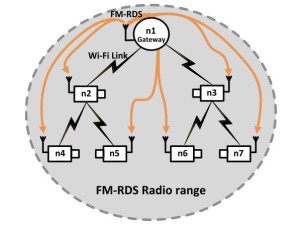The Solution
FM-WiFIX is an innovative solution, proposed in [2], to address the energy inefficiency problem of Wireless Multimedia Sensor Networks (WMSN). The main principle behind FM-WiFIX is to use the FM Radio Data System (RDS) as an out-of-band control channel, over which a scheduling mechanism would instruct the network’s nodes to switch on /off their Wi-FI interfaces, according to necessity. Similarly to IEEE 802.11 Power Saving Mode (PSM), the objective is to move the nodes to a power saving state whenever they are not needed to transmit, receive or relay data. However, with FM-WiFIX, instead of only moving the Wi-Fi interface to sleep mode, we can actually shut it down, thanks to the FM-RDS control channel, thus completely eliminating the Wi-Fi energy consumption when the node is in idle state. Since a FM transmitter/receiver consumes approximately ten times less energy than a Wi-Fi card in sleep mode [2], FM-WiFIX is by far a more interesting solution to increase energy savings. Moreover, as FM-WiFIX the out-of-band control channel also eliminates overheads such as ATIM frames in 802.11 PSM .

FM-WiFIX Reference Scenario [1]
To implement FM-WiFIX, it is assumed that WiFIX is used, in first place, to automatically create a logical treetopology rooted at the sink node, as illustrated in the FM-WiFIX reference scenario. As demonstrated in [12], this is a well-suited routing solution for a video monitoring scenario where the majority of traffic is exchanged from the video sensors to the sink node. FM-WiFIX is also built upon PACE, a scheduling mechanism proposed in [11], as an evolution to WiFIX, to address the performance issues of WMSNs caused by hidden nodes and throughput unfairness. Being two of the three major problems solved by PACE, FM-WiFIX addresses the energy inefficiency problem using a FM-RDS based control channel to turn on and off the Wi-Fi radio interfaces. Thereby, it is possible to mitigate the energy inefficiency problem while keeping the performance enabled by PACE and the backwards compatibility with legacy Wi-Fi devices [2]. Since FM radio signals have a great coverage area, only one FM transmitter, located at the gateway, is enough to cover the entire WMSN area (this was verified on the experiments described on the Weekly Report from March, 9th – March, 15th). Thus, this solution only requires the deployment of an extra FM receiver for every WMSN node and the above-mentioned FM transmitter at the gateway.
Methodology
As stated in Objectives, the main goal of this thesis is to implement the FM-WiFIX solution into a real video surveillance system. Therefore, the final goal is to have a proof-of-concept prototype to demonstrate the system operation and evaluate the solution on a real context.
To accomplish this goal, first we must choose all the hardware and software required and verify their suitability for our work. Second, we will proceed to the adaptation of the FM-WiFIX solution to the real requirements of a video monitoring scenario. Third, we will implement the FM-WiFIX along with the existent PACE and WiFIX implementations. Fourth, we will test the achieved prototype to identify problems and find optimizations. Fifth, we will proceed to a second iteration of implementation and testing, applying the identified optimizations and fixing possible bugs. Finally, having the final version of the prototype, we will retrieve enough data to proper evaluate its performance and quantify the gains achieved with the combination of the three solutions.


